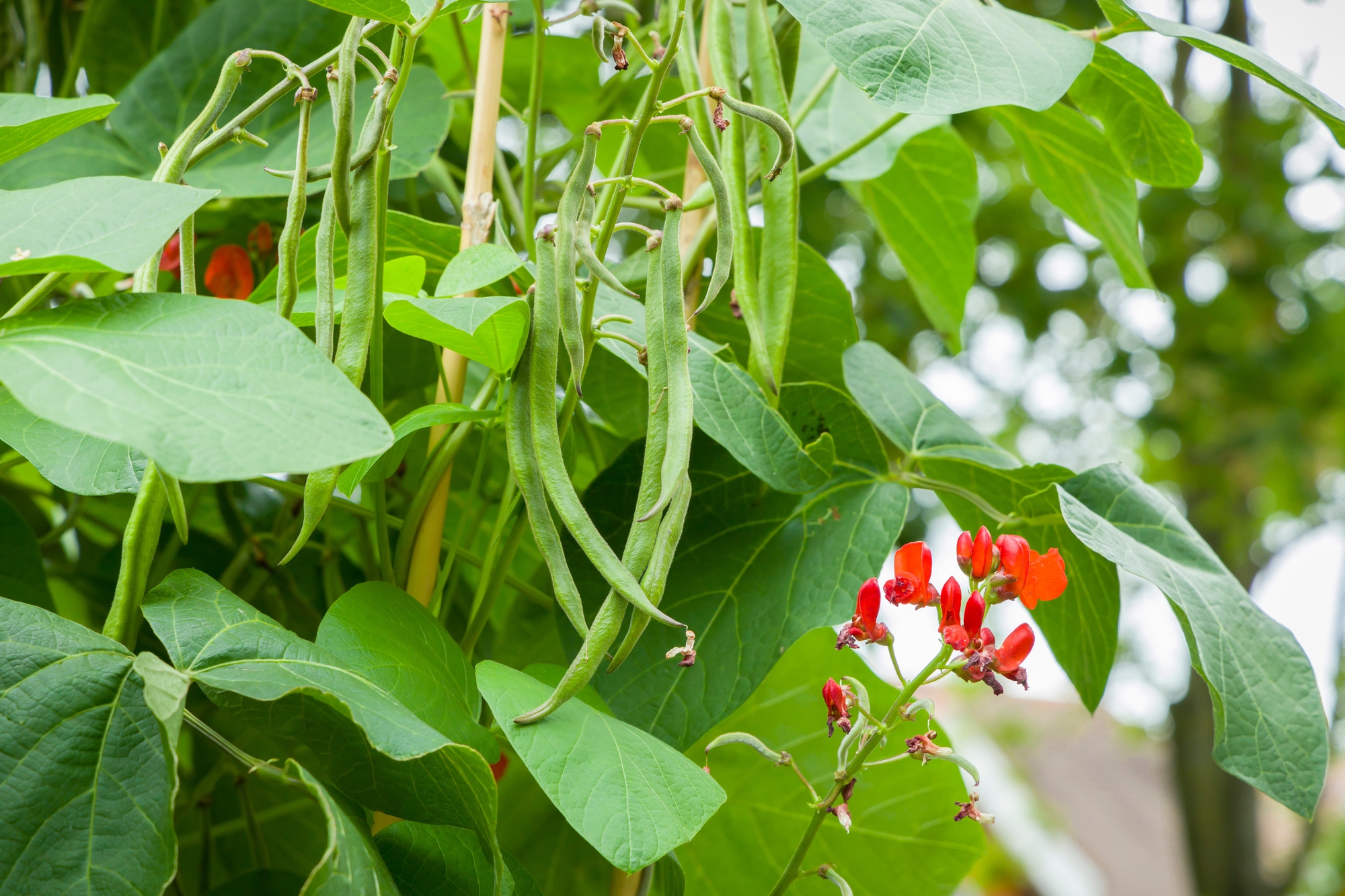Beans Donation Tracker
Quick Links: How & Where to Grow | Temperature | How to Care For | Harvest Signs | Harvesting | Support & Pruning | Pests | Companions | Varieties | Preservation | Recipes | Michigan Tips | Fun Facts
🌱 How & Where to Grow Beans:
- Wait for 60°F soil (late May) – beans absolutely will not germinate in cold soil!
- Plant seeds 1 inch deep, 2-4 inches apart for bush types, 4-6 inches for pole types.
- Space rows 18-30 inches apart for bush beans, 36 inches for pole beans.
- Install supports for pole varieties at planting time – 6-8 foot stakes or trellises.
- Sunlight: Full sun (6-8 hours) for best production.
- Soil Type: Well-drained soil with pH 6.0-7.0.
- Soil Amendment: Light compost only – beans fix their own nitrogen!
Pro tip: Inoculate seeds with rhizobia bacteria for better nitrogen fixation and increased yields.
🌡️ Temperature Guidance:
Critical 60°F minimum soil. Frost-tender. Nights above 50°F.
- Planting: Wait for consistent 60°F soil temperature – cold soil causes seeds to rot.
- Growing: Optimal temperatures 65-85°F.
- Beans stop growing below 50°F and are killed by any frost.
- Flowers drop in extreme heat above 90°F.
Michigan’s late May to early June planting ensures warm soil and avoids late frost damage!
💧 How to Care for:
- Consistent Moisture: Critical during flowering and pod development.
- Watering: 1 inch weekly – water at soil level to prevent disease.
- Mulch: 2-3 inches after plants are established to retain moisture.
- Fertilizer: Minimal needed – side-dress with compost at flowering if soil is poor.
- Weeding: Keep weed-free when young – mature plants shade out weeds.
📏 Harvest Signs:
Snap when firm and crisp. Shell when plump. Dry when pods rattle.
- Snap beans: Harvest when pods are pencil-thick and seeds barely visible.
- Shell beans: Wait until pods are plump and beginning to dry.
- Dry beans: Leave until pods are brown and beans rattle inside.
- Regular harvesting encourages more pod production!
Check plants every 2-3 days during peak season – beans mature quickly!
🧺 Harvesting:
Pick carefully to avoid damaging plants. Harvest when dry. Use both hands.
- Always harvest when plants are dry to prevent disease spread.
- Use two hands – one to hold stem, one to pull pod.
- Pick regularly – overripe pods signal plant to stop producing.
- Morning harvest after dew dries provides best quality.
- Handle gently – bruised beans deteriorate quickly.
🪜 Support & Pruning:
Bush beans need no support. Pole beans require 6-8 foot structures.
- Pole bean supports: Teepees, trellises, or single poles work well.
- Install at planting – adding later damages roots.
- Train young vines clockwise around poles.
- No pruning needed – beans naturally produce until frost.
- Pinch tips only if plants outgrow supports.
🪲 Michigan Pests:
Mexican bean beetle, aphids, Japanese beetles, bean mosaic virus.
- Mexican bean beetles – copper-colored with black spots. Hand-pick adults and yellow egg masses.
- Aphids – cluster on growing tips. Blast off with water.
- Japanese beetles – skeletonize leaves. Use row covers or hand-pick.
- Bean mosaic virus – causes mottled leaves. Plant resistant varieties.
🫱🏽🫲🏼 Companions:
Excellent with corn, squash, potatoes, carrots. Avoid onions, garlic.
- Three Sisters planting: Corn provides support, beans fix nitrogen, squash shades soil.
- Potatoes benefit from nitrogen while deterring Mexican bean beetles.
- Carrots grow well between bean rows.
- Summer savory improves growth and flavor.
- Avoid alliums (onions, garlic) which inhibit bean growth.
🌿 Varieties:
Bush: ‘Provider’, ‘Blue Lake 274’. Pole: ‘Kentucky Wonder’, ‘Scarlet Runner’.
- ‘Provider’: 50 days, bush, excellent disease resistance, produces in cool weather.
- ‘Blue Lake 274’: 58 days, bush, classic green bean flavor.
- ‘Kentucky Wonder’: 65 days, pole, heirloom favorite, very productive.
- ‘Scarlet Runner’: 75 days, pole, ornamental flowers, edible beans.
- ‘Cherokee Trail of Tears’: 85 days, pole, black beans, historical variety.
🫙 Preservation:
Freeze blanched 3 minutes. Pressure can only. Dry on plants.
- Freezing: Blanch whole beans 3 minutes, cool, freeze in meal portions.
- Pressure canning: Only safe method – never water bath can beans.
- Drying: Leave pods on plants until brown, shell, finish drying indoors.
- Pickled: Dilly beans make great refrigerator pickles.
- Fresh storage: Keep unwashed in perforated bags 5-7 days.
🧑🏽🍳 Recipes:
Green bean casserole, three bean salad, dilly beans, bean soup.
- Classic green bean almondine with butter and toasted almonds.
- Southern-style green beans slow-cooked with ham hock.
- Asian stir-fried beans with garlic and ginger.
- Fresh bean salad with herbs and vinaigrette.
- Traditional succotash combining beans with corn.
✋🏼 Michigan Tips:
- Wait until Memorial Day weekend for safe planting.
- Use row covers for early plantings if soil is warm.
- Succession plant every 2 weeks through July for continuous harvest.
- Choose disease-resistant varieties for humid Michigan summers.
- Plant pole beans on north side of garden to avoid shading other crops.
- Fall beans planted in early July often have fewer pest problems.
🧠 Fun Facts:
- Beans fix atmospheric nitrogen through root nodules containing rhizobia bacteria.
- The Three Sisters method has been used by Native Americans for over 1,000 years.
- Each bean plant can fix up to 50 pounds of nitrogen per acre!
- There are over 40,000 bean varieties in the world.
- Lima beans release cyanide when attacked by pests as a defense mechanism.
- The longest bean pod recorded was 48 inches long!
- Michigan produces over 200 million pounds of dry beans annually, ranking 2nd in the US.


0 Comments